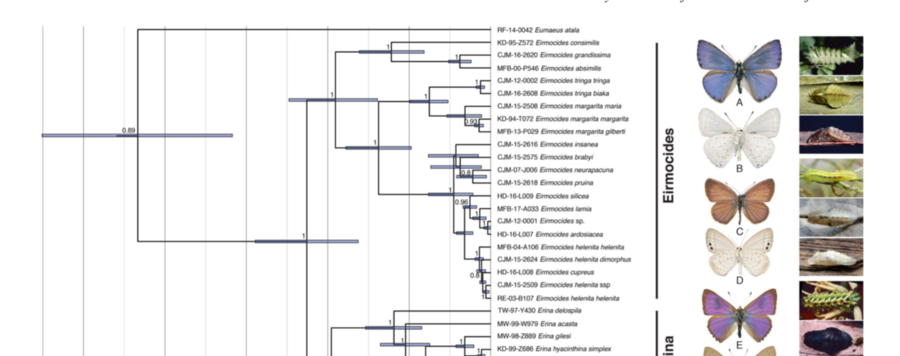
Evolution of the Candalidini
The butterfly tribe Candalidini is geographically restricted to Australia and mainland New Guinea and its adjacent islands. With 60 species and subspecies, it represents a large radiation of Papilionoidea in the Australian region. Although the species-level taxonomy is relatively well understood, the number of genera is uncertain, varying from two to eight. We reconstructed the phylogeny of the Candalidini based on a 13-locus hybrid enrichment probe set (12.8 Kbp: COI, Thiolase, CAD, CAT, DDC, EF1-a, GAPDH, HCL, IDH, MDH, RPS2, RPS5, Wingless), including all previously recognized genera and 76% (28/37) of the species-level diversity of the tribe. Maximum likelihood analysis recovered the Candalidini as a strongly supported monophyletic group. In conjunction with morphological characters, the phylogeny provided a robust framework for a revised classification in which we recognize four genera, 37 species and 23 subspecies. The genus Nesolycaena Waterhouse & R.E. Turner is considered in synonymy with Candalides Hübner, and four other genera are not recognized, namely, Holochila C. Felder, Adaluma Tindale, Zetona Waterhouse and Microscena Tite. Of the four valid genera, the absimilis group (23 species) is placed in the newly described genus Eirmocides Braby, Espeland & Müller gen. nov. (type species Candalides consimilis Waterhouse). The erinus group (six species) is assigned to Erina Swainson, which is reinstated. Chrysophanus cyprotus Olliff is assigned to Cyprotides Tite, which is also reinstated as a monotypic genus. The remaining seven species are placed in Candalides sensu stricto. Overall, we propose 47 new nomenclatural changes at the species and subspecies levels, including the synonymy of Holochila biaka Tite as Eirmocides tringa biaka (Tite) syn. nov. et comb. nov. and recognition of Candalides hyacinthinus gilesi M.R. Williams & Bollam as a distinct species Erina gilesi M.R. Williams & Bollam stat. rev. et comb. nov. A dated phylogeny using Bayesian inference in BEAST2 and biogeographical and habitat analyses based on the DEC model in BioGeoBEARS indicated that the ancestor of the Candalidini most likely evolved in rainforest habitats of the mesic biome in situ on the Australian plate of Southern Gondwana during the Eocene (c. 43 Ma). A major period of diversification occurred in the Miocene, which coincided with aridification of the Australian continent, followed by a further episode of radiation in montane New Guinea during the Plio-Pleistocene.





